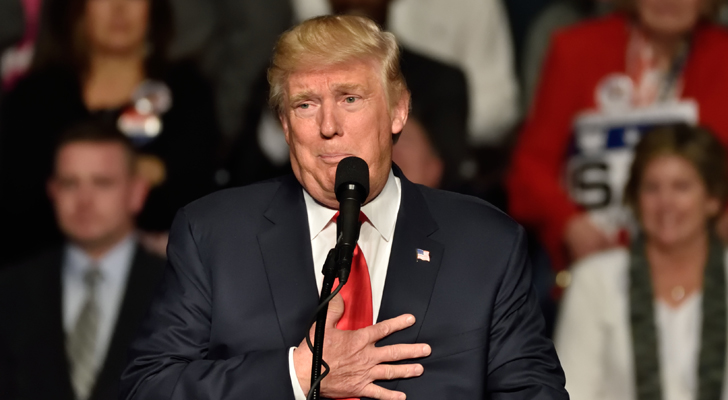The fact that Donald Trump appeared on a network other than Fox is amazing in and of itself but what he said about interest rates and the Federal Reserve July 19 on CNBC should have investors very concerned.
Here’s why.
A Strong Economy
If the American economy is as strong as everyone thinks it is, including Jerome Powell, Chairman of the Federal Reserve, further interest rate hikes should help keep inflation in check and the good times rolling along.
“Our policies reflect the strong performance of the economy and are intended to help make sure that this trend continues,” Powell said July 17 before the Senate Banking Committee.
The Fed is expected to increase interest rates twice more in 2018 and possibly as many as three increases in 2019.
Some experts view this many increases as extremely aggressive, possibly leading to a recession as early as the summer of 2019.
Trump’s opinion is that the White House is doing all kinds of great things to keep the economy moving including the corporate tax cut, individual tax cuts, reduced regulatory overhang, etc.; he doesn’t think interest rate increases are the right call when many of America’s competitors are still using cheap money.
I think he’s afraid to find out if the economy is for real or not. Perhaps, he should spend a little less time worrying about the Fed and a little more time figuring out how to trade in good faith with America’s allies.
The Yield Curve
Presently, the 2-year Treasury yield is 2.61%, and the 10-year yield is 2.85%; it is the smallest spread since before the last recession.
Natixis’ chief economist for the Americas is Joseph LaVorgna. He believes the yield curve could invert (the 2-year Treasury yield rises above the 10-year yield) in October after the next interest rate hike, a reliable indicator of a looming recession.
“It’s going to invert and it’s going to be a mistake,” LaVorgna told CNBC July 17. “It’s going to take an equity pullback and wider credit spreads. We’re going to price the ‘Powell put’ and then the Fed will try to uninvert the curve.”
Interestingly, should this happen in October, history suggests the markets could start to unravel by next fall putting an end to a what by then would be a decade-long bull market.
A Return to Normal
Everyone knew the day would come when the Fed would begin lightening its balance sheet, which grew by $4.3 trillion between 2008 and 20014, to stimulate the economy.
Starting in 2017, it began reducing the size of its balance sheet by approximately $40-$50 billion per month. In 2018, it will drop $230 billion in bonds from its balance sheet and another $600 billion next year — all to return its balance sheet to a healthy state of being.
The problem is that central banks around the world have all done the same thing creating a global economy built on debt.
“Even though we have begun to gradually normalize the size of the balance sheet, it remains exceptionally large by historical standards,” Esther George, CEO of the Federal Reserve Bank of Kansas City said recently. “It is still likely putting downward pressure on longer-term rates, working at odds with efforts to achieve policy neutrality.”
Did you know that the federal funds rate was 5% in 2007? That’s 300 basis points higher than where it is today and well above its low of 0.25% in the dog days of the recession.
Higher interest rates give the administration an additional tool to fight the next recession which is likely coming a lot sooner than we would have thought even six months ago.
The Bottom Line on Interest Rates
Last December, I stated that the president’s tax plan would put the U.S. into a recession because it was precisely the wrong prescription for sustained economic growth at precisely the wrong time in the economic cycle.
If Trump was smart, he would have saved his tax plan for when a recession hits — that’s more likely given his ongoing trade war with the rest of the world — but he didn’t do that, so here we sit with one of the only viable solutions being for the Fed to put a halt to interest-rate hikes.
That’s like momentarily taking the crack away from the addict. It solves the short-term problem but does absolutely nothing for solving this country’s addiction to debt.
Frankly, I’d like to see a return to 5% interest rates so corporations would stop borrowing money to buy back stock and instead focus on growing their businesses.
We got to full employment on cheap money, and now it’s time to pay the price.
Trump knows it.
Hence why he’s so openly critical of Jerome Powell’s stance on interest rates. He realizes the end of the Trump economic revitalization plan is near.
As of this writing Will Ashworth did not hold a position in any of the aforementioned securities.
Legendary Investor Louis Navellier’s Trading Breakthrough
Discovered almost by accident, Louis Navellier’s incredible trading breakthrough has delivered 148 double- and triple-digit winners over the past 5 years — including a stunning 487% win in just 10 months.
Learn to use this formula and you can start turning every $10,000 invested into as much as $58,700.
Click here to review Louis’ urgent presentation.

